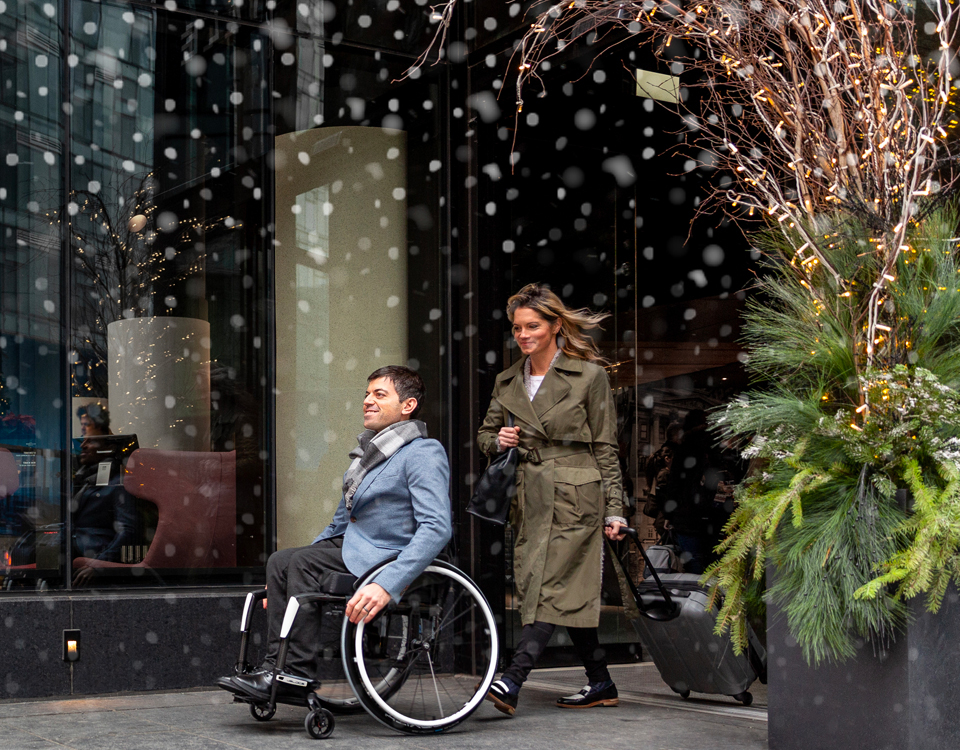Wheeling in a Winter Wonderland
As the colder weather is approaching it is now time to complete those annual responsibilities that come along with preparing for cold and SNOW!
As the colder weather is approaching it is now time to complete those annual responsibilities that come along with preparing for cold and SNOW!
Just as we would ensure our home and vehicle are ready for colder temperatures, we should be doing the same for our mobility device. Here we will review some things which can be done to ensure you are well prepared for the winter elements and the challenges they can bring.
Along with winter weather comes terrain which is more difficult to navigate. First, and even despite the weather, we always recommend ensuring your mobility device is optimal and customized for you. A wheelchair which is properly configured, as lightweight as possible and includes appropriate options/accessories is going to make sure you are as efficient as possible with propulsion. Wheelchair material can be a factor in colder temperatures whether it has decreasing performance or is cold to the touch. Material such as carbon fiber has an ultra-low coefficient of thermal expansion making it an ideal material for extreme temperatures, allowing the device to perform the way it was designed despite the elements.
Motion Composites’ brand ambassador Joey Desjardins confirms: “Wintertime definitely brings some challenges when it comes to mobility. Ensuring that both your equipment and your body are ready for it is a must! Beyond the inconvenients, you can still have a lot of fun.”
Ensuring you possess the proper wheelchair skills is also important. Snow can be a big factor in limiting the performance of casters and is known to obstruct what was previously an accessible area. Being able to transverse a curb or propel short distances in the wheelie position can prevent casters getting stuck and allows you to overcome these barriers. Also, due to the unfriendly nature of the winter environment there is a higher likelihood that you could fall out of your wheelchair. Having the ability to either right the wheelchair and independently get back into it or to instruct someone else to assist you is important. For some of these wheelchair skills and others visit the Dalhousie Wheelchair Skills Program: https://wheelchairskillsprogram.ca/en/
Next, we recommend you ensure your mobility device is in good working condition. This includes completing routine maintenance to check that all hardware is in place, secure and all features are working properly, including wheel bearings and wheel locks. “One of the most important things to do is prepare your wheels! Make sure to keep everything greased and clean. If possible, use mountain tires, they can make a huge difference” says brand ambassador Jeremy Landry.
It is also particularly important throughout the winter months to clean your wheelchair. Salt and sand are used on roads and sidewalks which can clog wheel bearing and corrode hardware. For a more detailed list of regular maintenance visit this previous blog on Maintaining your Wheelchair for Top Performance.
Rear wheels and hand rims are an important aspect of independence but when the environment changes sometimes the equipment should too. Having a second set of wheels to use outdoors in a snowy environment can be of benefit. This outdoor set off wheels should include a more robust tire which is wider and has knobbier treads and softer rubber, this increases friction allowing for more grip. Some users will even slightly deflate air tires to increase surface contact area improving traction. Higher friction hand rims, like the Newton Air Grip, can also assist with propulsion in rougher terrain or wetter weather allowing for more friction between your hands and the rim. A pair of wheelchair gloves can also aid with increasing friction as well as warmth in colder weather.
There are also after-market devices which can be added to manual wheelchairs which can help in snowy terrain. Wheelblades are an easy to adjust binding which fixes to the front casters of a manual wheelchair allowing them to operate more like skis. Wheelblades optimally distribute the weight of the wheelchair on the ground, preventing the casters from sinking into snow. Power add-on devices are well known for assisting manual wheelchair users’ navigate more difficult terrain. In snowy conditions a front power add-on is usually of benefit as it lifts the front casters off the ground allowing them to avoid getting caught up in snow. When evaluation options, we recommend contacting your health professionnal to make the best choices according to your situation.
Lastly, we recommend whenever traveling outdoors in cold or low-visibility weather you should be dressed appropriately. Warm clothing will help protect you against the outer elements and this is particularly important for those who have decreased sensation; But also wearing bright visible clothing with reflectors or lights will help other see you to increase your safety.
Whether you are someone who loves the snow or you just put up with it for a few months of the year because you have no choice, ensuring you and your wheelchair are well equiped will make things easier, safer and might even make things a little bit more fun!
